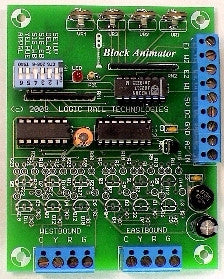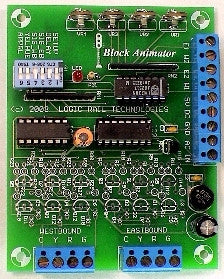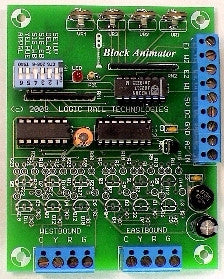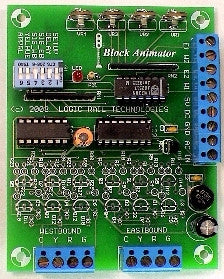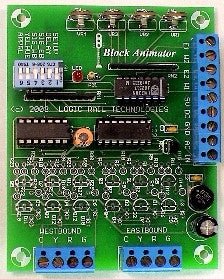Logic Rail BAD-CC - Block Animator All Scale
Logic Rail BAD-CC - Block Animator All Scale is backordered and will ship as soon as it is back in stock.
Couldn't load pickup availability
Description
Description
Logic Rail BAD-CC - Block Animator All Scale
Re-creating near-prototypical signal behavior without spending lots of money!
Use the infrared version (-IR suffix; 4 sets of emitters & detectors included) under any layout lighting condition.
Bi-directional control of 2 block signals; An eastbound (left to right) train will cause signal EB to transition from green to red when sensor E2 is covered. It will remain red until sensor E1 is covered and then uncovered at which time it will change to yellow. After a delay (see below) the signal will change back to green. A westbound (right to left) train will cause signal EB to transition from green to red when sensor E1 is covered. It will remain red until sensor E2 is covered and then uncovered at which time it will change back to green. Just like the prototype! Signal WB will behave similarly with respect to the opposite direction of travel and sensor W1 and W2.
You can see a video of the BA in action on a customer's layout. Click on this link. Thanks to Mike Komo for permitting us to share his video!
Block Animator Features:
Versions for all types of signals:
BA-1/BA-1-IR for controlling searchlight (2-lead or 3-lead bipolar LEDs) or 3-light (G,Y,R) LED-based signals wired with a common anode (positive) such as those from Tomar, NJ International, Oregon Rail Supply, and BLMA (#4025, 4030, 4031, 4035, 4036, 4037, 4038, 4039) (see our Documents page for a special application note on using the BLMA 4 head signal bridge!)
"TrueLens" and selectable yellow hue for searchlight signals; TrueLens duplicates the prototype signal behavior of having the signal BRIEFLY show yellow when it transitions from Clear (green) to Stop (red).
Current limiting resistors included
BA-2/BA-2-IR for controlling searchlight signals constructed with a single 2-lead or 3-lead bipolar LED (e.g. Tomar) OR constructed with three individual Green, Yellow and Red LEDs wired with a common anode (positive) behind a single "lens" such as those from BLMA (#4001, 4050, 4051) and NJ International (#2343)
"TrueLens2" for all signals and selectable yellow hue for bipolar LED signals; TrueLens2 duplicates the prototype signal behavior of having the signal BRIEFLY show red when it transitions from Approach (yellow) to Clear (green). Click here to see a video.
Current limiting resistors included
BAD-SBCA/BAD-SBCA-IR for controlling Tomar semaphore motors, 3-light and Pennsy/B&O position light bulb-based signals such as those from NJ International (NJI), LED-based position light signals wired with a common anode (positive) such as those from Tomar.
BAD-CC/BAD-CC-IR for controlling Pennsy/B&O position light and 3-light LED-based signals wired with a common cathode (negative) such as those from Integrated Signal Systems (ISS) and Atlas.
Current limiting resistors included
Signal aspects sequenced prototypically based on direction of travel
Yellow delay (i.e. when train leaves the "next block") is selectable (10 or 30 seconds)
Approach Lighting capable (signal is dark until train approaches!)
Correct aspects will be shown even if a train covers a sensor and then backs up, or if a train stops between sensors.
Requires no modification to track wiring or rolling stock
Each sensor has its own sensitivity adjustment and the Block Animator provides a setup mode for making the adjustment process easier
Infrared versions (-IR) powered from 7-9V AC or 9-12V DC (such as our WT1A together with our 12VPSR); draws about 360mA (or more when used with bulb-type signals)
Specifications
Specifications
-
Scale-
-
Product Type-
-
Height
-
Width
-
Depth
